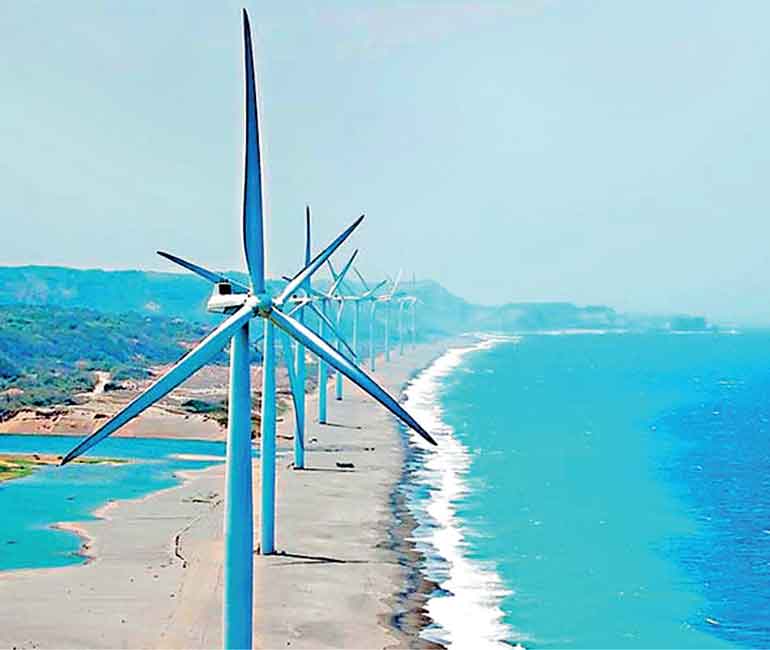Saturday Nov 29, 2025
Saturday Nov 29, 2025
Wednesday, 6 March 2024 00:20 - - {{hitsCtrl.values.hits}}

The panellists viewed Mannar as a pristine location and failed to acknowledge the serious threats facing the island’s ecology on multiple fronts
|
 Having attended the 27 February WNPS hosted media conference that highlighted ecological threats faced in Mannar due to the proposed wind farm development by the Adani group, I am sharing my views below:
Having attended the 27 February WNPS hosted media conference that highlighted ecological threats faced in Mannar due to the proposed wind farm development by the Adani group, I am sharing my views below:
First, I wish to present the synopsis of a public lecture titled, “Mannar Wind Power and Avian Issues” that I delivered seven years ago at the Institution of Engineers SL on 2 March 2017:
Meeting the growing electric power demand presents Sri Lanka with challenging options. Rapid expansion of wind power capacity can help to reduce coal-based power generation that undermines national energy security and harms the environment.
Wind power – growing rapidly worldwide – is not immune from environmental impact with avian issues prominent on Mannar Island where wind project development is planned. Since harnessing renewable energy and protection of fauna and flora are national priorities, a sensible development plan must be implemented to meet the power sector expansion program.
Avian habitat protection advocacy groups must refrain from opposing wind projects on the basis of inadequate and outdated knowledge, incorrect assumptions and emotively expressed points of view. Parties concerned about Sri Lankan environmental heritage must think rationally and work together to support development of wind power while taking steps to mitigate/minimise impact on avian activity in the vicinity of wind farms.
Today, SL continues to face serious challenges on the power sector expansion front. The LNG option is difficult to execute due to legal and regulatory risks and inherent volatility of LNG prices while coal power is out of favour (unable to finance).
Pursuing renewable energy development is the viable option and thankfully, SL is blessed with abundant renewable energy resources (wind and solar). Government policy is for the power sector to be renewable energy dominant by the year 2030.
Mannar wind project development
Mannar has been earmarked for wind project development for over a decade with resource assessments and environmental studies conducted. The ecological sensitivities in Mannar were noted and recommendations made to mitigate environmental impacts. A plan was prepared to develop up to 400MW of wind power capacity in Mannar.
The first phase development of 100MW moved forward with the EIA report presented for public review and comment. While the adequacy and omissions in the report were questioned by concerned citizens, the reality is that a 100 MW wind project (first phase) is developed and has been in commercial operation for three years. Valuable lessons can be drawn from this project for adopting mitigatory measures to address avian impact on future project developments.
Mistakes have been made. Avian fatalities occur on the 220 KV overhead transmission line (sized to evacuate up to 400MW of wind generated electricity) that crosses the southern periphery of the Vankalai Sanctuary. This transmission line should have been installed underground (expensive option). Since this line is here to stay, studies should be conducted to identify vulnerable avian types for implementing mitigatory measures to reduce fatalities.
There are also reports that avian collision incidents at the 100MW phase one wind plant (Thambapavani) are above what was predicted. This must be investigated through analysis of data and steps taken to mitigate. The incidents may be related to endemic birds rather than those from migratory flocks since the more organised movements of these flocks are detected via radar.
The 250 MW Adani wind project in Manar is phase two and a 276-page EIA Final Report with 415 pages of annexures has been completed and posted for public review and comment.
Once again environmentalists and citizens are raising concerns and questioning the adequacy of these studies. “Why choose Mannar” was a question raised by a panellist at the WNPS Media Conference.
Should Mannar be a hazard-free environment for our avian guests?
The avian expert on the panel described Sri Lanka as the southernmost destination of the Central Asian Flyway and acts as a vital global hub for migratory birds who fly long distances from northern Europe, and we are obligated to offer them protection.
The expert failed to mention that these migratory birds arrive on the shores of Sri Lanka after facing multiple hazards both natural and man-made over the duration of their long journey.
They endure the bird hunters of Europe, poachers in central Asia, Middle East and Pakistan and then run the gauntlet of transmission lines and wind farms in south India. They also fall victim to contaminated water.
The European Commission Birds Directive recognises the legitimacy of hunting wild birds as a form of sustainable use. It therefore allows the hunting of 84 huntable species, provided this is done in a sustainable manner that does not jeopardise their survival.
Mannar is not pristine
The panellists viewed Mannar as a pristine location and failed to acknowledge the serious threats facing the island’s ecology on multiple fronts.
Walk the beaches of Mannar during the monsoon season and observe the debris of torn nylon fishing net remnants, foam flotation devices, plastic bottles, etc. Explore the near shore islands at Adams Bridge and observe the trapped plastic debris. The islands act like a sieve that traps the wind and wave driven debris towards shore. The debris is from fishing boats that operate in the gulf of Mannar. Walk the dunes of Adam’s Bridge National Park and note the shreds of plastic mixed with sand – the result of monsoon winds and abrasive action of the sand on thin plastic materials. These are based on the writer’s observations made over the past 10 years.
Mannar is urbanising rapidly. Shrublands are cleared for housing and traffic density is increasing. These activities present a serious threat to the fauna and flora on the island due to habitat loss, noise, and emergence of man-made hazards. Poorly planned urbanisation of Mannar is a bigger threat to the habitat than well sited and competently operated wind farms.
As in the case in other wetland regions in the world, it is quite likely that migratory birds in the Mannar region perish because of vehicle collisions. The most common victims are ground-dwelling birds and waterbirds. These occurrences (if any) should be recorded.
National planners challenge
A national planner must take decisions based on a multiple set of circumstances. How should a planner who views Mannar as an excellent wind energy zone tackle the avian issue? Providing a hazard-free environment for these avian guests is not realistic. National economic development requires sector prioritisation and electricity is a critical one.
Wind farms located at close proximity to wetlands is not a new phenomenon. Thus, Mannar is not an exception. Experts covering various fields should work as a team and collaborate to formulate rules and guidelines to cover matters such as setback from sensitive zones, adoption of mitigatory measures, collection of data from operational wind farms for analysis, etc. The experiences drawn in Mannar will become useful as more project developments take place in wind resource rich regions of SL.
I intend to address specific items covered by the media conference panellists in a follow-up article. They relate to collision risk assessment modelling, flood impacts, excavations, alternative sites with lower ecological impact, purchase of ‘green’ energy by a foreign investor-operated project at above the market price, etc.
(The writer is a Renewable Energy Specialist and can be reached via email: [email protected].)